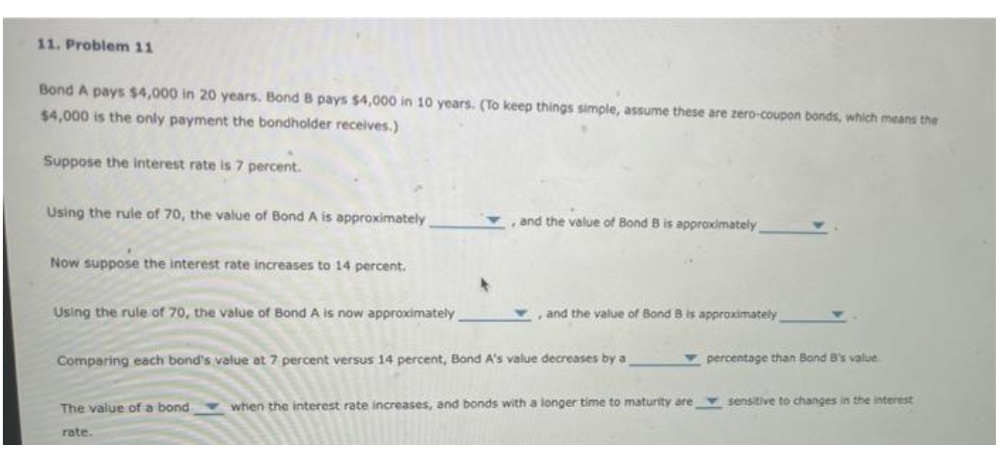11. Problem 11 Bond A pays $4,000 in 20 years. Bond B pays $4,000 in 10 years. (To keep things simple, assume these are zero-coupon bonds, which means the $4,000 is the only payment the bondholder receives.) Suppose the interest rate is 7 percent. Using the rule of 70, the value of Bond A is approximately ,and the value of Bond B is approximately Now suppose the interest rate increases to 14 percent. Using the rule of 70, the value of Bond A is now approximately v , and the value of Bond 8 is approximately Comparing each bond's value at 7 percent versus 14 percent, Bond A's value decreases by a percentage than Bond Bs value. The value of a bond when the interest rate increases, and bonds with a longer time to maturity are v sensitive to changes in the interest rate.
11. Problem 11 Bond A pays $4,000 in 20 years. Bond B pays $4,000 in 10 years. (To keep things simple, assume these are zero-coupon bonds, which means the $4,000 is the only payment the bondholder receives.) Suppose the interest rate is 7 percent. Using the rule of 70, the value of Bond A is approximately ,and the value of Bond B is approximately Now suppose the interest rate increases to 14 percent. Using the rule of 70, the value of Bond A is now approximately v , and the value of Bond 8 is approximately Comparing each bond's value at 7 percent versus 14 percent, Bond A's value decreases by a percentage than Bond Bs value. The value of a bond when the interest rate increases, and bonds with a longer time to maturity are v sensitive to changes in the interest rate.
Essentials of Economics (MindTap Course List)
8th Edition
ISBN:9781337091992
Author:N. Gregory Mankiw
Publisher:N. Gregory Mankiw
Chapter19: The Basic Tools Of Finance
Section: Chapter Questions
Problem 3PA
Related questions
Question
2

Transcribed Image Text:11. Problem 11
Bond A pays $4,000 in 20 years. Bond B pays $4,000 in 10 years. (To keep things simple, assume these are zero-coupon bonds, which means the
$4,000 is the only payment the bondholder receives.)
Suppose the interest rate is 7 percent.
Using the rule of 70, the value of Bond A is approximately
and the value of Bond B is approxdmately
Now suppose the interest rate increases to 14 percent.
Using the rule of 70, the value of Bond A is now approximately
and the value of Bond B is approximately
Comparing each bond's value at 7 percent versus 14 percent, Bond A's value decreases by a
percentage than Bond B's value
The value of a bond
when the interest rate increases, and bonds with a longer time to maturity are v sensitive to changes in the interest
rate.
Expert Solution
This question has been solved!
Explore an expertly crafted, step-by-step solution for a thorough understanding of key concepts.
This is a popular solution!
Trending now
This is a popular solution!
Step by step
Solved in 5 steps

Knowledge Booster
Learn more about
Need a deep-dive on the concept behind this application? Look no further. Learn more about this topic, economics and related others by exploring similar questions and additional content below.Recommended textbooks for you

Essentials of Economics (MindTap Course List)
Economics
ISBN:
9781337091992
Author:
N. Gregory Mankiw
Publisher:
Cengage Learning

Principles of Economics, 7th Edition (MindTap Cou…
Economics
ISBN:
9781285165875
Author:
N. Gregory Mankiw
Publisher:
Cengage Learning

Principles of Macroeconomics (MindTap Course List)
Economics
ISBN:
9781285165912
Author:
N. Gregory Mankiw
Publisher:
Cengage Learning

Essentials of Economics (MindTap Course List)
Economics
ISBN:
9781337091992
Author:
N. Gregory Mankiw
Publisher:
Cengage Learning

Principles of Economics, 7th Edition (MindTap Cou…
Economics
ISBN:
9781285165875
Author:
N. Gregory Mankiw
Publisher:
Cengage Learning

Principles of Macroeconomics (MindTap Course List)
Economics
ISBN:
9781285165912
Author:
N. Gregory Mankiw
Publisher:
Cengage Learning

Brief Principles of Macroeconomics (MindTap Cours…
Economics
ISBN:
9781337091985
Author:
N. Gregory Mankiw
Publisher:
Cengage Learning

Principles of Economics (MindTap Course List)
Economics
ISBN:
9781305585126
Author:
N. Gregory Mankiw
Publisher:
Cengage Learning

Principles of Macroeconomics (MindTap Course List)
Economics
ISBN:
9781305971509
Author:
N. Gregory Mankiw
Publisher:
Cengage Learning